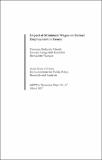| dc.date.accessioned | 2021-02-12T09:32:34Z | |
| dc.date.available | 2021-02-12T09:32:34Z | |
| dc.date.issued | 2007 | |
| dc.identifier.uri | http://repository.kippra.or.ke/handle/123456789/2632 | |
| dc.description.abstract | This paper uses time series data to analyze the impact of minimum wages on employment in the private and public formal sectors in Kenya. An error correction model is used to analyse the long-run and short-run effect of minimum wage on employment in the two sectors. The results show that minimum wage has a significant negative effect on employment in the formal public sector, both in the short-run and long-run. However, in the private sector, minimum wage has a positive significant effect on employment in the long-run but has no effect on employment in the short-run. Increase in real average wage has a negative effect on employment in the private sector. The results also show that both negative and positive shocks on the economy have an impact on employment. The model shows that short-run disturbances feed into the long-run employment path. The results imply that it is the cumulative effect of minimum wage that has an impact on employment. Thus, limiting the frequency of adjusting minimum wage upwards, such as changing minimum wage after two years instead of changing it every year as currently the practice in Kenya can help minimize the negative impact of minimum wage on employment. | en |
| dc.language.iso | en | en |
| dc.publisher | The Kenya Institute for Public Policy Research and Analysis (KIPPRA) | en |
| dc.relation.ispartofseries | DP/67/2007 | |
| dc.subject | Minimum Wage | en |
| dc.subject | Formal Employment | en |
| dc.subject | Labour Demand | en |
| dc.subject | Market Clearing Wage | en |
| dc.subject | Skilled Labour | en |
| dc.title | Discussion Paper No. 67 of 2007 on Impact of Minimum Wages on Formal Employment in Kenya | en |
| dc.type | KIPPRA Publications | en |
| ppr.contributor.author | Manda, Damiano K.; Kosimbei, George K. & Wanjala, Bernadette | |

